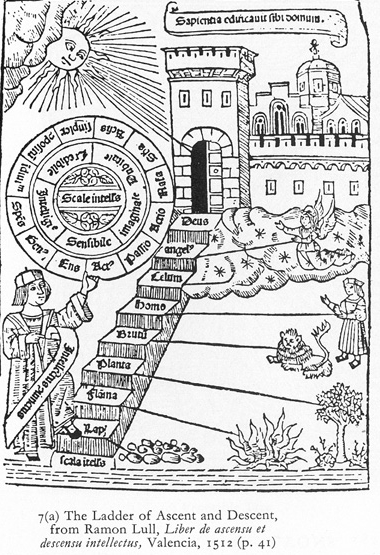Abracadabra: Language, Memory, Representation
The Art: Memory system or Proto-logic?
We have read two versions of Ramon Llull's Art, and both Francis Yates and Umberto Eco seem to agree that it is neither memory system nor Logic. Yates objects because it make no use of images. Eco objects because it is not a "real" logical system. What the hell is it?
The art is basically a system by which one can pose a large number of theological questions and answers. It uses symbols, the alphabet, to represent different things, and therefore appears to be like symbolic logic. The letters cannot, however, represent anything-- they stand for particular concepts drawn from theology and logic.
On the other hand, it allowed for a kind of flexibility that Aristotelian logic did not: such logic was verbal and required that the speaker hand-craft each argument. Aristotelian logic is also a syntactic logic, not a semantic one; this means it is possible to say "All dogs are cats; I am a dog, therfore I am a cat" and though the statement is logical, it's premises are false. Llull's logic rested on semantics. Even if it is possible to say "Greed is Good" using the system, the user needs to know that this is a false statement and to exclude it.
It's use was primarily to instruct others in the theological complexity of Christianity. Conversion could be made simpler through using the machine to attempt to force agreement.
The Art is therefore, a bit of both a memory system and a logic. Like Camillo's theater, it 'contains' all of theology, all the necessary arguments to "prove" that Christianity is the one true religion. Like Logic, it does this through permutation and combination of symbols. It is, in actual fact much closer to what we call today, a logic diagram, such as a Venn diagram or a Markov chain. It allows for the "mechanization of thought."
How it works.
There are several versions, generally refered to as Ars magna
The complete system is sometimes called the ars
generalis ultima
The first version, considerably complex, ars
demonstrativa
The later version, after discovering how little people understood it,
was radically shortened, made more general, called the
ars Brevis.
.
The Ars Brevis consists of four figures and an alphabet.Each figure has a different function
- First figure A makes us of what Llull calls the "dignities". The dignities are drawn directly from Scholastic Logic, sp. John Scotus of Erigena; they are much like the primitives, or axioms of theology. By connecteing all the lines it is possible to create permutations of all the dignities (with the exception of tautologicals).
- Second figure T is actually 3 overlapping triangles, each with sub-species that are associated with them (1: difference, concordia, contrariety; 2: beginning, middle, end; and 3: major, equality, minor).
- Third figure is a table of the combinations in the first figure
- Fourth Figure is actually movable and allows for permutation in groups of three of all the letters.
- In addition to the figures, there are 18 principles which must be learned by heart in order to operate the device
- In order to make the machine a device which can be used to ask questions, there are nine times of questions.
- Finally there are three sets of nine: Subjects, virtures and vices that are also used to ask questions

- More legible versions Figure A and Figures 3,4,5
Ars Descriptiva - Considerably more complex, with 23 letter alphabet and 9 figures
 Llull's
Llull's
 Lull's Ladder
Lull's Ladder